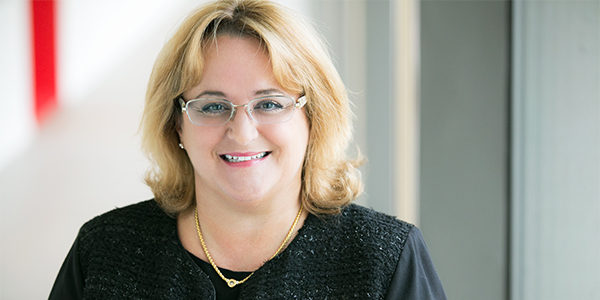The master supply chain builder: interview with Kathy Wengel

As a child, Kathy Wengel loved to build with Lego bricks. She enjoyed selecting blocks of different sizes, shapes, and colors and then bringing them together into a unified whole.
Her job today as executive vice president and chief global supply chain officer at the health-care giant Johnson & Johnson (J&J) is not much different. For instance, she recently co-led an effort to redesign and rebuild J&J's supply chain and quality operating models. This entailed taking all of the disparate parts of the health-care company's global operations—and those of its suppliers and customers—and melding them together into an integrated process that's focused on the end customer.
Wengel and her team proved to be master builders. The redesign propelled J&J's operation into the ranks of truly world-class supply chain organizations. In 2019, the company captured the number-eight spot on the analyst group Gartner's annual "Supply Chain Top 25" list.
Wengel believes the initiative's success lies in the diverse and global supply chain teams the company has spent years building. Johnson & Johnson is committed not only to bringing people with diverse experiences and perspectives onto its teams but also to broadening those team members' perspectives by moving them through varied roles around the globe.
Wengel herself is an example of this. During her 31-year career at J&J, she has served in a variety of positions in a variety of places, including manager of manufacturing engineering at a J&J site in Puerto Rico and general manager of one of J&J's largest production facilities in Italy. She has also served as vice president of quality and compliance for the company's Europe, the Middle East, and Africa (EMEA) and Asia Pacific regions and as the corporation's first chief quality officer.
In addition to her day-to-day activities, Wengel has made time to give back to the profession. She is active in many industry organizations, including the Council of Supply Chain Management Professionals (CSCMP), the global standards organization GS1 Global, the National Association of Manufacturers, and AWESOME (Achieving Women's Excellence in Supply Chain Operations, Management, and Education).
In recognition of her service and leadership, CSCMP recently presented Wengel with its Distinguished Service Award (DSA), which honors an individual for significant, consistent, and career-long contributions to the logistics and supply chain management disciplines. She recently talked with DC Velocity Editor at Large Susan Lacefield about her career path and her vision for the profession's future.
Q: What do you see as the top challenges facing supply chain executives going into 2020, and how is Johnson & Johnson addressing those challenges?
A: In my opinion, a top challenge for every supply chain executive is a question I ask myself every day: How do we find the best talent to drive future innovations for patients, and ultimately the growth of our company? I spend more than a third of my time working on this challenge: accelerating talent development, identifying the most promising future leaders, establishing a culture of self-direction and accountability, and ensuring we equip our entire workforce with the skills and capabilities they will need for the future.
From artificial intelligence (AI) to automation and the Internet of Things, the world of supply chain is quickly evolving as technology challenges us to think bigger and innovate faster. To deliver top-quality products to our patients, customers, and consumers, our Johnson & Johnson workforce needs to include the best and brightest minds. We must also continually expand our pool with respect to diversity and experience, searching for and developing talented people from all backgrounds who have the right blend of skills, curiosity, and passion that will continue to fuel our company's innovation engine and maintain our position as a leader in the industry.
Q: What is your proudest work-related achievement, and why?
A: I'll actually give you two. The first is the excellence with which we implemented our redesigned supply chain model for J&J. Over the past decade, we have completely transformed the role of supply chain for our corporation and, more importantly, for our customers. While this journey never ends, I want to recognize our more than 50,000 supply chain associates for their fantastic work.
Second, and very much related to the first, would be building more diverse global teams at every step of my career. I've seen so many times how results are dramatically improved when you put people with different experiences, from different backgrounds, and with different perspectives together and give them a problem to solve.
We are very proud of the external recognition we've received, including being ranked this year by Gartner as one of the Top 10 supply chains in the world across all industries and the top-ranked health-care company. And I'm extremely honored and humbled at being named the recipient of the 2019 Distinguished Service Award from CSCMP. Each of these recognitions is due to the strong, dynamic, and diverse teams we have that are tackling the complex challenges that come at us in health care each day.
Q: How have things changed for women in supply chain management since you entered the profession? What further changes would you like to see?
A: Over the years, I have seen an increase in the number of women in supply chain management roles and supply chain overall, but there are still too few of us in leadership positions. This is reflected in the very small percentage of women (approximately 5%) who occupy the top supply chain spot in Fortune 500 companies. Supply chain is such an interesting and exciting place to be, and there are many talented women leading and innovating—I know thousands of them! We can all do a better job in telling that story and supporting younger women who have the interest and drive to succeed in this space.
I'm very proud to have a gender-balanced (50/50) globally diverse supply chain leadership team here at Johnson & Johnson. We need visible and vocal women in supply chain roles who can inspire the next generation of supply chain and STEM2D (science, technology, engineering, math, manufacturing, and design) professionals. That is why I dedicate a portion of my time to serving as the executive sponsor of Johnson & Johnson's "Women's Leadership & Inclusion" and "Women in STEM2D" initiatives.
Q: What advice would you give someone who's just starting a career in supply chain management?
A: I'm asked this question a lot, and I've realized that the lessons we learn early on in our careers will influence the way we work and lead teams, often for decades. I always encourage people to ask lots of questions to help understand the overall context of a situation and where it sits in the priorities of the business and our customers. I certainly asked a lot of questions at the beginning of my career, and my team can confirm for you that I still do today! By hearing what others have to say, on the corporate level, on the manufacturing lines, and especially on the customer side, we can gain a better understanding of the vast health-care landscape and make decisions that are in the best interest of the company and our employees.
More specifically, I'd tell a newcomer that when an interesting opportunity presents itself, raise your hand! I'm an advocate of stepping outside of your comfort zone and taking opportunities or positions that may seem different or unusual; in my experience, that's when you learn the most. Each new opportunity and relocation pushed me to new perspectives and helped me to grow as a leader. Those are the moments that define you, teach you, and set you apart from others.
Q: You're active in a number of industry associations and university programs. Why do you feel that's important?
A: It is critical to spend part of your time outside of your own organization's walls. We do not exist in a vacuum. We're part of a vast—and constantly evolving—global health-care ecosystem, where the effects of even minor regulatory or process changes can reverberate throughout our operations.
That is why I'm proud to serve as chairman of the board of GS1 Global, an organization that sets and maintains global standards for the exchange of critical business data to ensure patient safety and supply chain efficiency. I also sit on the board of the National Association of Manufacturers in the U.S. and am on the advisory board of AWESOME. And I very much enjoy spending time with university students getting ready to embark on supply chain careers.
I see all of these activities as part of my responsibility as a leader to find and support the next generation of supply chain leaders. They are the ones who will usher in the next technology breakthroughs to meet the changing needs of a market that we can only imagine today.
Related Articles

Copyright ©2024. All Rights ReservedDesign, CMS, Hosting & Web Development :: ePublishing